Why gender matters - Centre for Social Responsibility in Mining ...
Why gender matters - Centre for Social Responsibility in Mining ...
Why gender matters - Centre for Social Responsibility in Mining ...
You also want an ePaper? Increase the reach of your titles
YUMPU automatically turns print PDFs into web optimized ePapers that Google loves.
Some examples of <strong>gender</strong>-related aimag data procured from the basel<strong>in</strong>e study<br />
Category<br />
Household dynamics<br />
and vulnerability<br />
Gender-specific f<strong>in</strong>d<strong>in</strong>gs – Aimag Umnugovi<br />
– Around one fifth of the households are woman-headed.<br />
– Female participants from focus group discussions (FGD) felt that husbands should be<br />
the major breadw<strong>in</strong>ner and they did not m<strong>in</strong>d if wives engaged <strong>in</strong> paid jobs <strong>in</strong> addition<br />
to their housework.<br />
– Women’s participation <strong>in</strong> economic activities was reported to have significantly <strong>in</strong>creased<br />
<strong>in</strong> recent years.<br />
– FGD participants reported that men/husbands and women/wives participate equally <strong>in</strong><br />
mak<strong>in</strong>g decisions regard<strong>in</strong>g household property ownership and <strong>in</strong>heritances with household<br />
<strong>in</strong>come distributed equally to household members.<br />
– Many FGD participants stated that domestic violence is fairly common <strong>in</strong> their communities.<br />
Case study 3<br />
Population and health<br />
Education and<br />
social <strong>in</strong>stitutions<br />
– Births amongst adolescent girls account <strong>for</strong> 8.6 per cent of all births, a relatively high<br />
<strong>in</strong>dicator <strong>in</strong> Mongolia.<br />
– S<strong>in</strong>ce 1980, fertility has decl<strong>in</strong>ed by more than five children per household.<br />
– Life expectancy at birth <strong>for</strong> females (2005-2007) is 71.82, much higher than males,<br />
which is 61.21.<br />
– A decl<strong>in</strong>e <strong>in</strong> the sex ratio of the Mongolian population is expected: it is assumed that<br />
life expectancy at birth will widen due to women experienc<strong>in</strong>g greater improvement <strong>in</strong><br />
their life conditions than men.<br />
– The absolute majority of people were literate: 96.6 per cent of men and 97.6 per cent<br />
of women.<br />
– The aimag has active organisations represent<strong>in</strong>g various social groups, <strong>in</strong>clud<strong>in</strong>g women,<br />
the elderly, Indigenous people, and environmental protection.<br />
Key f<strong>in</strong>d<strong>in</strong>gs<br />
The basel<strong>in</strong>e report <strong>in</strong>cludes a<br />
description of Mongolian culture,<br />
which covers <strong>gender</strong> roles and<br />
responsibilities, both historically<br />
and currently. As stated <strong>in</strong> the<br />
report’s section on Mongolian<br />
culture, “unlike their counterparts<br />
elsewhere <strong>in</strong> Asia, Mongolian<br />
women historically enjoyed high<br />
status and freedom. S<strong>in</strong>ce fertility<br />
was valued over virg<strong>in</strong>ity, the<br />
Mongols did not place the same<br />
emphasis on female purity as<br />
found <strong>in</strong> the Islamic societies <strong>in</strong><br />
Asia. Although women had legal<br />
equality with men under socialism,<br />
they were burdened with the<br />
responsibilities of housework and<br />
childcare as well as their labour<br />
<strong>for</strong> wages” (p35 <strong>Social</strong> Economic<br />
and Environmental Basel<strong>in</strong>e Study<br />
2008). The basel<strong>in</strong>e report also<br />
touches on k<strong>in</strong>ship relationship<br />
from the 13th century to date<br />
and more recent socialist system<br />
adm<strong>in</strong>istrative arrangements that<br />
impacted traditional structures.<br />
The Mongolian culture and<br />
nomadic way of life is described<br />
with a detailed account of husband<br />
and wife household workloads.<br />
The study recognises the<br />
fast grow<strong>in</strong>g m<strong>in</strong><strong>in</strong>g sector <strong>in</strong><br />
Aimag Umnugovi, and details<br />
how residents want to benefit<br />
from new opportunities but<br />
at the same time ensure their<br />
concerns regard<strong>in</strong>g losses of<br />
traditional culture, environmental<br />
degradation and social <strong>in</strong>equality<br />
are attended to. Notwithstand<strong>in</strong>g,<br />
the basel<strong>in</strong>e evaluates the process<br />
of development <strong>in</strong> the aimag,<br />
by means of an <strong>in</strong>tegrated focus<br />
that considers aspects of the<br />
economic, social, environmental<br />
and <strong>in</strong>stitutional elements of<br />
the region, <strong>in</strong>clusive of <strong>gender</strong><br />
specific issues.<br />
Next steps<br />
Once the <strong>in</strong>vestment agreement<br />
is signed, Oyu Tolgoi will move<br />
to commission an <strong>in</strong>tensive socioeconomic<br />
and environmental<br />
impact assessment <strong>in</strong> the project<br />
area, and will use some of the<br />
<strong>in</strong><strong>for</strong>mation from the basel<strong>in</strong>e<br />
study as a benchmark. The<br />
impact assessment team will be<br />
required to ensure that <strong>gender</strong> is<br />
considered <strong>in</strong> the methodology<br />
<strong>for</strong> the primary research.<br />
For further <strong>in</strong><strong>for</strong>mation, the full<br />
English version of the study is<br />
available at: http://en.umnugovi.<br />
mn/static/687.shtml?menu=817. 3<br />
39
















![[PDF] Community Development Toolkit - CommDev](https://img.yumpu.com/48616495/1/184x260/pdf-community-development-toolkit-commdev.jpg?quality=85)
